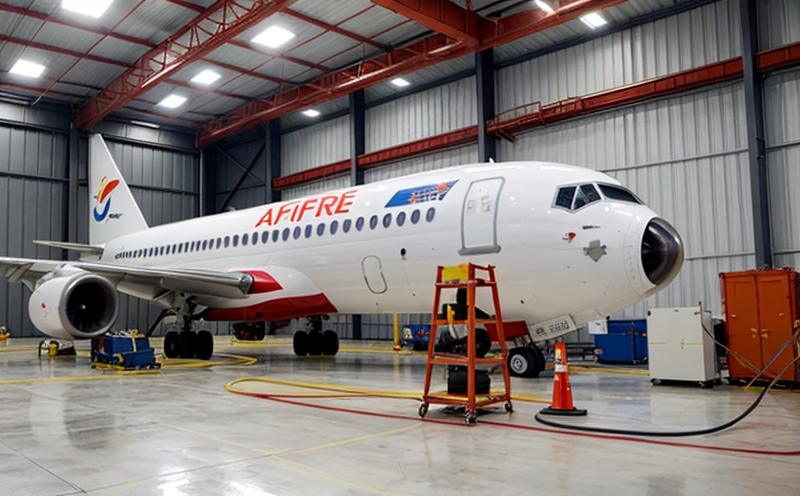Reaction-to-Fire Testing of Emergency Exits and Slides
The Reaction-to-Fire (RFT) testing of emergency exits and slides is a critical component in ensuring the safety and reliability of aerospace products. This testing ensures that materials used in these components meet stringent fire safety standards, thereby protecting passengers and crew during emergencies.
Fire hazards can pose significant risks during an aircraft evacuation scenario. Therefore, rigorous testing is essential to determine how well emergency exit systems and slides withstand exposure to flame or heat without compromising their integrity or causing hazardous conditions for those using them. This service focuses on evaluating the flammability characteristics of materials used in these components according to international standards such as ISO 19627-3:2020.
The testing process involves subjecting a representative sample of the material to controlled flame exposure under specific environmental conditions. The goal is to assess not only the ignition behavior but also the self-extinguishing properties and structural integrity retention post-exposure. By simulating real-world scenarios, this test helps manufacturers identify potential weaknesses in design or material selection early on.
Testing these components requires specialized equipment capable of replicating various aspects of a fire event. The apparatus used includes chambers designed to simulate different types of fires relevant to aviation applications. These may range from small pilot lights to larger propane flames depending upon the type of exit being tested. Additionally, temperature sensors and gas flow meters ensure accurate measurement throughout each trial.
Once testing is complete, detailed reports are generated summarizing all observations including any changes in appearance or physical properties observed during exposure as well as quantitative data related to time-to-ignition, flame spread rate, maximum heat release rates, etc. These insights provide valuable information for continuous improvement efforts aimed at enhancing overall safety performance.
Failure to meet required specifications could result in non-compliance with regulatory requirements which may lead to product recalls or even legal consequences. Hence, investing in thorough RFT testing early in the development cycle can help avoid costly mistakes later on while also improving brand reputation through demonstrated commitment to passenger safety.
Scope and Methodology
| Parameter | Description |
|---|---|
| Test Specimens | Representative samples cut from actual emergency exit materials. |
| Flame Exposure Conditions | Controlled temperatures and duration consistent with expected operational conditions. |
| Environmental Factors | Humidity levels, air currents affecting flame behavior. |
| Data Collection Methods | Infrared thermography, smoke density measurements, mass loss calculations. |
The scope of RFT testing encompasses multiple stages aimed at comprehensively evaluating the flammability properties of materials used in emergency exits and slides. Specimens are prepared according to ASTM D5752-18 guidelines before being subjected to controlled flame exposure inside a specially designed chamber. Throughout this process, various sensors continuously monitor key parameters such as temperature gradients, smoke production rates, and mass changes.
Post-exposure analysis involves both visual inspection of the specimen's condition alongside quantitative evaluation using advanced analytical techniques like FTIR spectroscopy if necessary. This dual approach ensures accurate assessment of structural integrity along with chemical composition alterations due to thermal degradation.
Eurolab offers unparalleled expertise and state-of-the-art facilities dedicated solely to aerospace fire safety testing. Our team comprises highly qualified professionals with extensive experience in the field, ensuring that every test conducted meets the highest standards of accuracy and reliability.
We employ cutting-edge instrumentation tailored specifically for aerospace applications allowing us to provide precise results even under demanding conditions. Our facility is equipped with multiple chambers capable of simulating different types of fires relevant to aviation scenarios, guaranteeing comprehensive coverage across all aspects of RFT testing.
Moreover, our commitment to quality extends beyond just technical proficiency; we also prioritize client satisfaction by offering flexible scheduling options and transparent communication throughout the entire process. Whether you need one-off tests or ongoing support for new product introductions, Eurolab is here to assist you every step of the way.
Quality and Reliability Assurance
- Compliance with international standards (ISO 19627-3:2020)
- Use of advanced instrumentation for accurate data collection
- Regular calibration of all testing equipment to ensure consistency
- Detailed documentation and reporting of each test conducted
- Access to historical data for trend analysis and continuous improvement
- Participation in inter-laboratory comparisons to validate results
At Eurolab, we understand that reliability is paramount when it comes to aerospace fire safety testing. That's why we have implemented robust quality assurance measures throughout our entire operation. From initial sample preparation through final report generation, every stage of the process adheres strictly to internationally recognized standards ensuring consistency and accuracy.
Our use of advanced instrumentation allows for precise measurement of key parameters during each test run while regular calibration ensures that all equipment remains in optimal working condition. Detailed documentation and reporting practices ensure transparency and ease of reference for future projects or audits.





